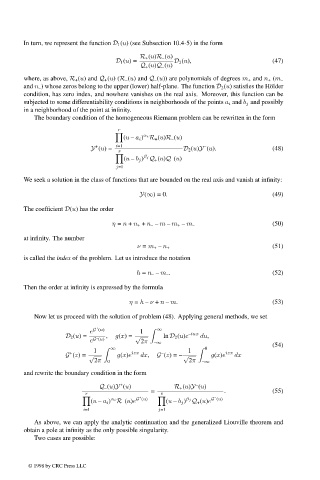Page 525 - Handbook Of Integral Equations
P. 525
In turn, we represent the function D 1 (u) (see Subsection 10.4-5) in the form
R + (u)R – (u)
D 1 (u)= D 2 (u), (47)
Q + (u)Q – (u)
where, as above, R + (u) and Q + (u)(R – (u) and Q – (u)) are polynomials of degrees m + and n + (m –
and n – ) whose zeros belong to the upper (lower) half-plane. The function D 2 (u) satisfies the H¨ older
condition, has zero index, and nowhere vanishes on the real axis. Moreover, this function can be
subjected to some differentiability conditions in neighborhoods of the points a i and b j and possibly
in a neighborhood of the point at infinity.
The boundary condition of the homogeneous Riemann problem can be rewritten in the form
r
(u – a i ) R + (u)R – (u)
α i
+
–
Y (u)= i=1 D 2 (u)Y (u). (48)
s
(u – b j ) Q + (u)Q – (u)
β j
j=1
We seek a solution in the class of functions that are bounded on the real axis and vanish at infinity:
Y(∞) = 0. (49)
The coefficient D(u) has the order
(50)
η = n + n + + n – – m – m + – m –
at infinity. The number
(51)
ν = m + – n +
is called the index of the problem. Let us introduce the notation
h = n – – m – . (52)
Then the order at infinity is expressed by the formula
η = h – ν + n – m. (53)
Now let us proceed with the solution of problem (48). Applying general methods, we set
+
e G (u) 1 ∞ –iux
D 2 (u)= , g(x)= √ ln D 2 (u)e du,
e G – (u) 2π –∞
∞ 0 (54)
1 1
+ izx – izx
G (z)= √ g(x)e dx, G (z)= – √ g(x)e dx
2π 0 2π –∞
and rewrite the boundary condition in the form
–
+
Q – (u)Y (u) R + (u)Y (u)
r = s . (55)
G (u) G (u)
–
+
α i
β j
(u – a i ) R – (u)e (u – b j ) Q + (u)e
i=1 j=1
As above, we can apply the analytic continuation and the generalized Liouville theorem and
obtain a pole at infinity as the only possible singularity.
Two cases are possible:
© 1998 by CRC Press LLC
© 1998 by CRC Press LLC
Page 507

